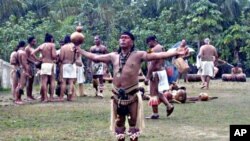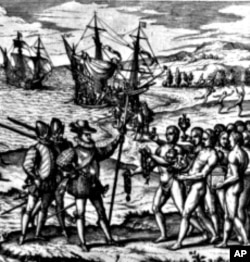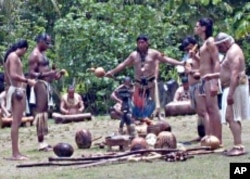A people thought to be dead for 500 years hope to prove they're still very much alive, thanks to the 2010 census.
The census counts everyone in the United States, including territories like Puerto Rico. Thousands of Puerto Ricans are rediscovering their indigenous heritage and plan to ensure that the U.S. government knows about them.
On a blustery day at the Texas state capital building in Austin, members of the Taino tribe rally to raise awareness about the 2010 U.S. census. Dr. Ana María Tekina-eirú Maynard leads the group in song. She's the tribe's tequina suania, meaning she directs and teaches ceremonial dances to Tainos in the United States.
Decimated tribe
She explains that the Tainos greeted Christopher Columbus when he landed in the New World in 1492, but the Spanish conquistadors who followed him decimated the tribe. Some Tainos managed to survive by fleeing to the mountains. But in the 1800s, Spain stopped counting indigenous people in the census of its colonies.
Tekina-eirú Maynard says that stripped thousands of full-blooded Tainos of their identity. "If you happened to be a Taino who lived up in the mountains and you weren't in the sun a lot and maybe your skin was a little lighter, then they threw you in the 'white' bucket."
Today, most history books say the Tainos were wiped out 50 years after the Spanish explorers arrived. After hundreds of years of mainstream thought that taught them the Tainos were dead, many Puerto Ricans forgot about their native ancestry.
Tainos like Tekina-eirú Maynard see the 2010 U.S. census as their chance to finally prove the history books are wrong.
"We are survivors," she says. "We are part of the people who went into the mountains to survive when the conquistadores were massacring our people."
DNA link to the past
In 2000, a study funded by the National Science Foundation revealed that more than 60 percent of Puerto Ricans have Taino blood.
The Cacike, or chief, of Tainos who are members of El Concilio Taino Guatu-Macu A Boriken, which is the nonprofit organization on the island that represents the tribe, said that study awakened a Taino consciousness in the Puerto Rican people. "The results showed that in every Puerto Rican, Taino blood runs in our veins."
Following the study, Puerto Ricans from across the island and many living on the mainland had their DNA tested by submitting samples of their saliva. Many began to identify themselves as Taino, and they started working to restore their traditions by studying the stories passed down by their grandparents.
The Cacike's wish now is for all Puerto Ricans to regain pride in their native heritage.
"Our history was written with Taino blood. The conquest cost the lives of three million people. Our beliefs were taken from us, and beliefs were imposed upon us at the point of sword and cannon. Today we are free," he says. "We believe as our ancestors believed. And we know our spirituality is genuine. It's true, like the light of the sun. It's so true it's like the wind. You cannot see it, but you can feel it."
Seeking official recognition
Although thousands of people now identify as Taino, the tribe has yet to receive official government recognition or the federal benefits that accompany it. So Tekina-eirú Maynard was excited to learn about questions added to the 2010 census that will allow them to declare their indigenous heritage on paper.
That is what Maria Rocha and Dr. Mario Garza are urging Latinos to do. The couple runs the Indigenous Cultures Institute, a Texas-based nonprofit that works to preserve native traditions.
Garza explains that on previous census forms, Latinos could only claim their race as 'white' or 'non-white'. "We're trying to educate these people that even if they identify as Hispanic, they still come from a very rich heritage and cultural background which is their indigenous part."
The Indigenous Cultures Institute has been sponsoring pow-wows around Texas to urge Hispanics with Taino heritage to complete the 10 questions on the 2010 census form.
Rocha and Garza tell members of their audience they can still recognize their Latin American heritage on question 8, which addresses ethnicity. Question 9 is the one that asks about race. Rocha and Garza tell Latinos to check their race as 'American Indian' and to write in their tribal affiliation in the space provided. That's where Puerto Ricans can identify themselves as 'Tainos.'
Rocha says her group's census campaign has also resonated with Latinos of other indigenous backgrounds across the U.S.
"People have a need to be out there and do something important for their ancestors," she observes, "not just register with the government or tick off themselves as a number. This has some significance to our people."
Putting a people back into the history books
When Dr. Ana Maria Tekina-eirú Maynard learned how she could identify herself as Taino on the census, she sent an email explaining the process to 5,000 people on her cultural center's email list.
"There will be thousands of Tainos who will check the box and write the word Taino," she says. "And I can't wait until the census is done and all of this happens."
At the Puerto Rican Cultural Center in Austin, she and her family practice aretos, or songs for ceremonial dances. Tekina-eirú Maynard wrote the songs and believes they were inspired by her ancestors. "I would sit on my back porch and these songs would just sort of come to me," she says.
Proud heritage
Her 13-year-old son, William plays a traditional drum that Tainos from Puerto Rico made for him.
He says playing the aretos brings him closer to his indigenous heritage. "This is a very native, very pure thing, which, especially for me, I have a connection to this. It's really like you can feel it in your heart."
Tekina-eirú Maynard says the best thing about reconnecting with her Taino ancestry is that she can finally help her family understand their origins.
"I feel like I am putting my family back on track. After 500 years — that they had gone to the mountains to hide and hid so well that they forgot who they were — I feel that I have a chance now to put my family back to where they belong. And you have no idea how meaningful that is to me."
That's why Dr. Ana María Tekina-eirú Maynard says she will continue raising the voice of the people until every history book says the Tainos are still here.













